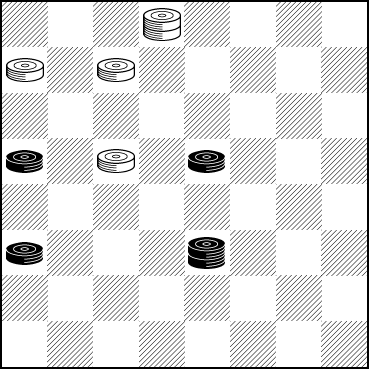The Checker Maven
Jump to navigationThe Engineer

Although your editor's degrees are in engineering, he's definitely not the kind of engineer shown above. Those engineers certainly earn a very nice living, and we suspect that quite a number of them play checkers while on the road.
Today's little problem was published decades ago by someone who simply called himself "The Engineer." We have no further information on who he might have been. Did he design bridges? Refine oil? Drive a train? Perhaps someone out there on the internet might know, but for now it remains an intriguing mystery.
His checker problem, though, won't stay a mystery for long.

BLACK
Black to Play, What Result?
B:WK31,28,27,19:B20,18,12,K10.
Despite the sometimes unfair (and annoying!) "what result" terms, the problem is fairly easy if you take an engineering approach and do a little organized analysis. No slide rules required, just some orderly checker thinking. Do your calculations and then click on Read More to see the solution.![]()
Solution
Our engineering analysis starts by asking: what choices does Black have? 20-24---1 deserves a further look; see the note below. But 18-23 or 12-16 lose a piece immediately with no compensation. That leaves 18-22 or a King move other than 10-15 (which throws away the King at once).
Let's look at 18-22 first. It loses pretty quickly:
18-22 19-16 12-19 27-24 20-27 31-6 White Wins.
How about a King move? They all turn out the same. In fact, there is nothing Black can do about White's threatened 19-16, except resign the game or try a pitch with 20-24 as described in the note.
10-14 19-16 12-19 27-24 20-27 31-22 White Wins.
10-7 19-16 12-19 27-24 20-27 31-22 WW.
10-6 19-16 12-19 27-24 20-17 31-22 WW.
Black can't re-engineer this position, and loses no matter what he tries.
1---Initially we didn't give 20-24 enough attention. Brian Hinkle wrote us post-publication and showed us some interesting lines of play. Although White still wins, these lines may represent Black's best defensive options. Black tries to develop enough compensation to draw by tying up White's pieces. It doesn't quite work against best play by White, but it does give White a few chances to go wrong.
Here's one:
20-24 27x20 18-23 20-16---2 10-14 16-11 14-10 28-24 23-27 31-26 27-32 26-23 32-28 23-18 28-32 18-15 10-6 24-20 32-28 11-8 etc. to a White Win.
And here's an even better one, in which White wins even though a man down:
20-24 27-20 18-23 20-16 10-7 28-24 23-27 31-26 27-32 26-23 32-28 23-18 28-32 19-15 12-28 18-23 to a White Win.
2---28-24 allows Black to get a draw: 20-24 27x20 18-23 28-24 23-27 31-26 27-32 26-23---3 32-28 23-18 10-6 20-16 28-32 16-11 32-27 24-20 27-24 19-15 24-19 and Black recovers his man for a very neat draw.
3---20-16 32-27 24-20 27-24 19-15 10x19 26-22 19-15 Black Wins!
Our thanks to Brian for sending us his enlightening re-engineering analysis. And, here's one more line of play from Ed Atkinson:
20-24 27-20 18-23 20-16 10-7 28-24 23-27 31-26 27-32 26-23 32-28 23-18 7-3 16-11 12-16 19-12 28-19 11-7*---4 3-10 18-15 White Wins.
4---Ed comments: "I'm glad that White has the pitch to breeches resource since 11-8 instead allows a piece down draw by 3-7."
You can email the Webmaster with comments on this article.
